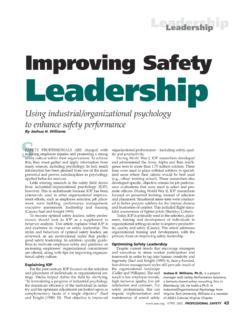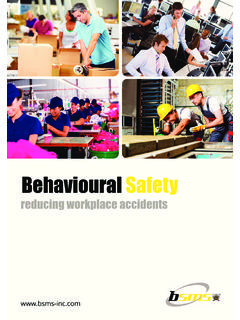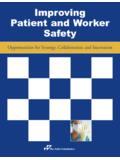Transcription of Officer Safety and Wellness Group Meeting Summary ...
1 O C TO B E R 2016. Officer Safety and Wellness Group Meeting Summary improving Law enforcement resilience L E S S O N S A N D R E CO M M E N D AT I O N S. This project was supported, in whole or in part, by cooperative agreement number 2014-CK-WX-K055. awarded by the Department of Justice, Office of Community Oriented Policing Services. The opin- ions contained herein are those of the author(s) or contributor(s) and do not necessarily represent the official position or policies of the Department of Justice. References to specific individuals, agencies, companies, products, or services should not be considered an endorsement by the author(s). or the Department of Justice. Rather, the references are illustrations to supplement discussion of the issues. The Internet references cited in this publication were valid as of the date of publication. Given that URLs and websites are in constant flux, neither the author(s) nor the COPS Office can vouch for their current validity. Recommended citation: Spence, Deborah, ed.
2 2017. improving Law enforcement resilience : Lessons and Recommendations. Officer Safety and Wellness Group Meeting Summary . Washington, DC: Office of Community Oriented Policing Services. Published 2017. O C TO B E R 2016. Officer Safety and Wellness Group Meeting Summary improving Law enforcement resilience L E S S O N S A N D R E CO M M E N D AT I O N S. Contents Letter from the Director.. v History of the OSW Group .. vii Overview of the October 2016 Meeting on resilience .. ix Part I. The Impact of Mass Casualty Events on Officer resilience 1. Initial Remarks. 3. Case Study Presentations. 5. Dallas, Texas. 5. Orlando, Florida. 7. San Bernardino, California. 8. Case Study Discussion about Planning for resilience .. 11. Recommendations for a Resilient Crisis Response.. 17. Part II. Building Physical and Emotional Health and resilience .. 21. What is resilience ?.. 23. Five Pillars of resilience .. 25. Physical Health.. 29. Emotional Health.. 33. Recommendations for Building resilience .
3 41. Conclusion.. 45. About the COPS Office.. 47. Letter from the Director Colleagues: In July 2016, we watched in horror as the events unfolded in Dallas, Texas, where five police officers were murdered. No doubt, your first concerns, like mine, were for the injured and murdered officers and their families. But we must also concern ourselves with the surviving officers, many of whom suffered emotionally in the aftermath of the shootings and experienced survivors' guilt for months. It would be easy to assume that the men and women who enter this profession know what they will face on the job and are prepared for it. Yet, the long-term effects of dealing with difficult, often dangerous people; sitting in a squad car for hours; working night shifts; and adapting to other work-related stressors can lead to problems such as obesity, heart attacks, alcoholism, substance abuse, accidental injuries, and even suicide. In recognition of the cost emotional trauma can take on the mental and physical health of law enforcement officers, the OSW Group convened a Meeting of law enforcement practitioners, men- tal health professionals, medical experts, and other stakeholders in October of 2016 to assist law enforcement agencies in identifying the best strategies and resources for helping law enforcement officers to build personal resilience .
4 By resilience , I mean the ability not only to withstand the pro- foundly disturbing effects of responding to a mass casualty event but to thrive amidst the daily challenges and work-related stress that come with being a law enforcement Officer . The following report, which covers the participants' discussion, offers their insights and recommen- dations for promoting mental and physical health the foundation of resilience . There is a great deal of practical information here, with advice that can benefit your entire staff and, as a result, improve relationships with your community. Officers who are mentally and physically healthy not only respond better to emergencies and other challenging situations but also relate better to the people they interact with, both on the street and in the precinct. On behalf of the COPS Office, I thank all who participated in the October Meeting , as well as our partners at the Bureau of Justice Assistance. I believe this eye-opening report is a must read for all law enforcement leaders.
5 The personal resilience of the men and women who put themselves in v harm's way for us every day should be a matter of deep concern to us all. Their mental and physical health are critical not only to their on-the-job performance but also to their individual and collec- tive Safety and that of the people they serve to protect. Participants in this Meeting stated that there is no way to completely prepare officers for the hor- ror of a mass casualty event but that having a detailed plan to deal with such an incident is key to maintaining Officer resilience . This report is an excellent first step. Sincerely, Russ Washington Acting Director Office of Community Oriented Policing Services vi improving Law enforcement resilience History of the OSW Group The Office of Community Oriented Policing Services (COPS Office) and the Bureau of Justice Assis- tance (BJA), a component of the Office of Justice Programs, formed the national Officer Safety and Wellness (OSW) Group in 2011 to bring attention to the Safety and Wellness needs of law enforce- ment officers following a number of high-profile ambushes on police.
6 Since 2011, the OSW Group has raised awareness, increased knowledge, and encouraged law enforcement agencies to adopt practices that recognize that a law enforcement agency's most valuable resources are the men and women who put their lives on the line every day in the name of protecting and serving their com- munities. For this reason, it is critical that the COPS Office and BJA with support from Depart- ment of Justice leadership research, discuss, and promote the best possible information to keep our nation's law enforcement officers safe on the job. To that end, the OSW Group , regularly brings together law enforcement practitioners, researchers, and subject matter experts to help amplify new and existing efforts to improve Officer Safety and Wellness in the field. The founding goals of the OSWG are to create an opportunity and environment for law enforcement organizations and researchers to collaborate on improving Officer Safety and Wellness ;. to bring together law enforcement organizations and researchers to share knowledge and infor- mation about Officer Safety and Wellness initiatives.
7 To broadly disseminate information and best practices to the field through the government and law enforcement organizational communications mechanisms. The OSW Group identified 16 priority areas, grouped into four main themes, on which to focus: I. Operational and emergency responses 1. Injuries and death from gunfire 2. Premeditated and unprovoked ambush situations 3. Rifle and long-gun threats and assault weapons 4. Task force operations (federal and local). 5. Offenders (behavior during incident and history) 6. Court security vii II. Leadership and management 7. Leadership and Safety practices 8. Equipment 9. Deployment strategies and communication technologies III. Mental and physical health and Wellness 10. Physical health ( , fatigue, alcohol, weight, and nutrition). 11. Psychological health 12. Maintaining good health 13. Former military in law enforcement IV. Training 14. Education and training 15. Emergency vehicle operation and Safety 16. Foot pursuit Safety Over the last six years, the OSW Group has discussed these critical Officer Safety and Wellness issues and produced a number of resources to encourage the nation's law enforcement agencies to adopt a culture that embraces the value of Safety and Wellness .
8 The COPS Office and BJA continue to strive to provide agencies with the tools necessary to develop effective programs that address some of the most persistent and prevalent Safety and Wellness issues facing law enforcement officers today. In the first half of 2016, the country witnessed an unprecedented number of police ambushes, the most notable being the July 2016 attack during which five Dallas, Texas, police officers were killed. Given this disturbing upward trend and the need to facilitate resilient officers and organizations, the OSW Group convened in October 2016 to discuss first-responder resilience and organizational health. This document is a Summary of that Meeting and provides readers with critical information, promising practices, and recommendations from law enforcement leaders at that Meeting . When first responders have the tools and support they need to take care of themselves and manage the stress and trauma of their jobs, the benefits far-reaching positive effects in both their personal and professional lives.
9 Safe and resilient officers help build safe and resilient communities. viii improving Law enforcement resilience Overview of the October 2016. Meeting on resilience T. he last several decades have seen a downward trend of violence against law enforcement offi- cers; however, the threat of on-the-job injury or death is still real for officers nationwide. For example, vehicular accidents remain a persistent and high cause of Officer deaths, but 2016. saw a noticeable uptick in the number of firearms-related Officer fatalities compared to recent These realities combined with the daily exposure to stress and trauma that result from working in a 24/7 profession that regu- larly requires officers to interact with people under some of the worst possible circumstances . highlight that policing can be a dangerous and potentially life-threatening job. Work-related stress has been asso- ciated with a number of negative outcomes, most notably physi- cal and mental health problems. However, such stress also can affect officers' families, colleagues, and, for officers who interact with the public on daily basis, the community.
10 Stress can lead to poor decision making and increase mis- takes, both of which may jeopardize the success of the mission and the Safety of the public. 1. 135 Law enforcement Officer Fatalities Nationwide in 2016, Preliminary 2016 Law enforcement Officer Fatalities Report (Washington, DC: National Law enforcement Officers Memorial Fund, 2016), ix To help address these issues, the COPS Office and BJA decided to focus the October 2016 OSW. Group Meeting on how to develop and support resilient officers and agencies. A law enforcement Officer 's individual resilience is essential for helping him or her to cope effectively with the stress inherent in the job. Individual resilience involves behaviors, thoughts, and actions that promote personal well-being and mental health. It refers to a person's ability to withstand, adapt to, and recover from adversity. 2 When first responders have the tools and support they need to take care of themselves and manage stress, the benefits have far-reaching positive effects in both their per- sonal and professional lives.







